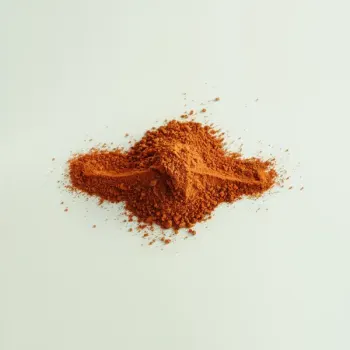Chili powder is a blend of spices with a mellow heat used to add complexity to dishes, while cayenne pepper is a pure ground powder that provides sharp, intense heat without altering the flavor profile of recipes.

Chili powder is a blend of ground, dried chili peppers with other spices like garlic powder, oregano, and cumin. It's commonly used in Tex-Mex and Mexican cuisine to add complexity and warm, mellow heat to dishes.

Cayenne pepper is a pure ground powder made from dried cayenne peppers. It's known for its sharp, fiery heat and is used to add a spicy kick to dishes without significantly altering their flavor profile.
Chili powder offers a complex flavor profile with moderate heat due to its blend of spices, whereas cayenne pepper provides a more intense and focused heat. The texture of chili powder is typically finer due to the mix of ingredients, and it comes from various chili peppers, as opposed to cayenne pepper's single source.

Your ultimate Recipe Box, Meal Planner, and Cooking Class all in one
In stews and soups, chili powder is best used for creating depth and a rounded warmth. Expect a multi-dimensional flavor with notes beyond just heat. Use it in the early stages of cooking to allow the flavors to meld. Cayenne pepper is ideal for adjusting the spiciness without altering the base flavors of your stew or soup. Add it in small increments and taste frequently to achieve the desired level of heat.
Chili powder works well in meat marinades for imparting a nuanced taste with a gentle kick. It's suitable for longer marination times due to its mildness and will complement other spices well. Use cayenne pepper when you want to add a bold and straightforward heat to your meat. As it is quite potent, a little goes a long way. Mix it with oil or acid to help it disperse evenly in the marinade.
For sauces and salsas, chili powder can create a complex base flavor that's perfect for dishes like enchiladas or chili. The additional spices in the blend add layers of taste that can complement tomatoes and other primary ingredients. Cayenne pepper is excellent for adding a clean, piercing heat to sauces and salsas. It's especially useful when you're aiming for a spicy profile without changing the sauce's intended flavor.
You can substitute cayenne pepper for chili powder (or vice versa) if you're solely looking to adjust heat levels. However, keep in mind that chili powder will add additional flavors and cayenne pepper will increase the spiciness. Start with small amounts and adjust according to taste.
Both chili powder and cayenne pepper contain capsaicin, which can boost metabolism. They are low in calories and may offer health benefits when consumed in moderation.
| Nutrient | Chili Powder ( per Teaspoon ) | Cayenne Pepper ( per Teaspoon ) |
|---|---|---|
| Fat | 0.4g | 0.3g |
| Sodium | 5mg | 1mg |
| Calcium | 7mg | 8mg |
| Protein | 0.4g | 0.2g |
| Calories | 8 | 6 |
| Carbohydrates | 1.4g | 1g |
Yes, cayenne pepper is generally spicier than chili powder due to its pure, undiluted form of hot peppers.
While you can substitute one for the other, keep in mind that chili powder has additional spices and will affect the flavor profile, while cayenne pepper will add more heat.
If you're out of both, consider using paprika for a mild heat or a pinch of red pepper flakes as a substitute.
To counter excessive heat from cayenne pepper, add more of the recipe's base ingredients, a touch of acid like lemon juice, or a dairy product to soothe the spiciness.
Both spices contain capsaicin, which has been linked to various health benefits, including pain relief and boosting metabolism.